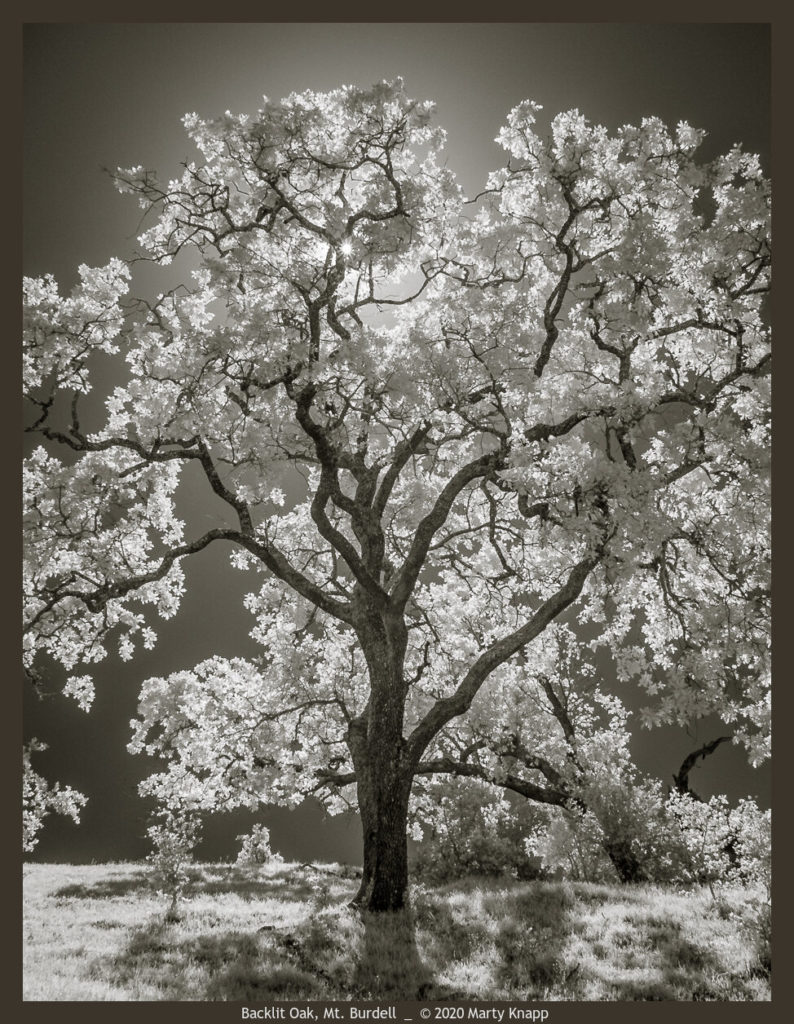In 2016 Brooks Jensen, publisher of Lenswork, featured a photo essay of my work, titled Infrared Trees, in his Lenswork Extended #125 edition. Included in this collection is Backlit Oak, which Brooks later reviewed in his online series, Looking at Images. I am honored to have had my photograph reviewed by Brooks, who has long been and continues to be an inspiration to me in my artistic efforts. You can read his review immediately below this image of Backlit Oak. The audio version, read by Brooks, is here:
Looking at Images with Brooks Jensen
Ansel Adams famously advised that any darkroom manipulations that were visible and obvious were an indication that they were done poorly. More succinctly, if you can see it, it ain’t right.
This, precisely, has always been my struggle with infrared photography. Until I saw this particular image by Marty Knapp, I always felt that viewing an infrared photograph simply screamed INFRARED. In fact, infrared photographs scream INFRARED so loudly, that I’m almost never aware of the subject, let alone the emotional or experiential content I am supposed to see in the artwork. Infrared photographs — like no others — suffer from their overpowering technological existence. Just my way of thinking about it, but I know some people love it.
The trick with all photographic technology is to use the technology that’s appropriate for the artistic and aesthetic statement we choose to make. So used, technology disappears into the artistic and aesthetic statement. When Eric Clapton plays a soulful blues riff on his guitar, we are not aware in the least what brand of guitar strings or pick he uses. We don’t even know the brand of the guitar! But there is no question that Eric Clapton does, and probably has made those technological choices because they are the very best of the available alternatives. This is no different for the graphic arts, photography included.
This photograph by Marty Knapp is, perhaps, the most effective use of infrared materials I’ve ever seen. It’s not that the infrared affect is subtle, but rather that it is perfectly appropriate for the sense of light, backlit illumination, skeletal structure, and the bright sunny day that he is hoping comes through in this photograph. In fact, if the leaves were dark green (as they would be with color film), or even dark gray (as they would be with panchromatic black-and-white film), they would fail to render the same sense of backlit illumination we see here. Rendered in infrared white and light gray tones, we can feel the warmth in the leaves and their intimate relationship with the sun.
And speaking of the sun, it seems critically important in this image that we can see the sun and its starburst affect. That changes the tones in the leaves in this image from merely white to brightly backlit. Imagine this image without the visible sun and you’ll see what I mean.
And finally, hopefully not beating a dead horse, as I’ve said so many times before, photography is about relationships. The three main players in this triad of relationships are the sun, the leaves, and the skeletal structure of the tree trunk and branches. Because the leaves are rendered in photographic infrared tones, the trunk and branches become more visible because of their contrast to the light colored leaves that form the backdrop. This is an exquisitely timed photograph, requiring the sun to be in the exact relationship to the tree so that Knapp’s angle of view contains the relatively open space on the side of the tree. Perhaps he was lucky, perhaps he planned this moment perfectly. Either way, it demonstrates how critical timing can be in landscape photography. Also, I secretly love that he demonstrates so well the silliness in all that business about the “golden hour.” Great photographs can be made at any time, in any light, when a sensitive photographer employs the right tools for the right reasons.

Congratulations – it is a beautiful photograph and demonstrates all that we love about your skill in rendering out love of the landscapes of the Pt. Reyes area.
Wonderful photo and superb review. You have taken infrared to a whole other level.